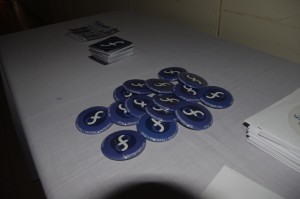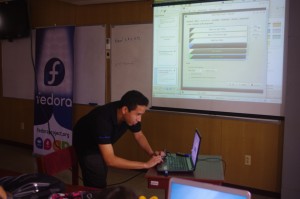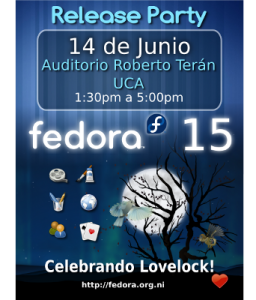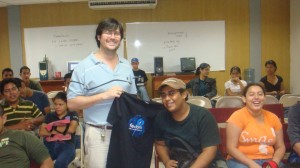Español abajo
Last 17th of July we gather to celebrate that we have a new version of Fedora 19. I felt that was something new this time. I did not have any talk to do. I was able to walk around, talk to people and take pictures. Fedora local community has grow up with several new talents. We did some plans, and work together to make a good event.
There was few people at the starting time, so we delay a bit showing “Tears of Steel” one the latest blender projects. We awarded the twenty first comers with Fedora buttons. I knew the schedule was turned upside down, but people was relaxed as they were paying attention to the speakers.

We opened with a introduction of the local community, how the initiative of Fedora school has helped people to gather skills to contribute to Fedora Project at Large. Next, there was a presentation about how to upgrade from one version of Fedora to the next, showing different approach. Yum-jitsu was the next talk and there was a reference to Seth Vidal and his great work. We have a guest speaker, Andres Reyes from Güegüe Comunicación talking about Saltstack. The demonstration was using Fedora, and later he commented some hints about using different Linux distros. The last presentation was about the new look and tools of the last version of GIMP featured on Fedora 19.
We run out of time with some talks remaining. We had a presentation of the new features of Fedora 19 focus on sysadmins. We also had a talk about the new spin Jam-KDE. I was ashamed that the last talk, regarding about female participation on our local community did not happened. Our speaker was ahead of the situation, and she approached the girls during the talks. She made arrangements to get together soon.

I walked around giving stickers to every people. We passed a paper sheet for people to sing in. We logged 26 persons, but we have more people. At some point I counted 30 persons at peak attendance, but we also have people coming and going.
We distributed 55 media, we get short on install media i386. Our estimates were close on the proportion of live media and install media, and also on architecture of 32 bits and 64 bits.

The timing was not good for some of the speakers, but they are just starting to do technical talk in public. I am happy to have new crew on board of our Fedora local community. Finally I would like to thanks the Linux User Grup of Universidad Centroamerica GUL-UCA and Professor Carlos Leal also from Universidad Centroamericana as the key people to secure the auditorium for us
Español
El pasado 17 de Julio nos reunimos para celebrar que tenemos una nueva versión de Fedora 19. Yo sentí que había algo nuevo esta vez. Yo no tenía ninguna charla. Me dio chance de caminar por el auditorio, hablar con la gente y tomar fotos. La comunidad local de Fedora ha crecido con varios nuevos talentos. Nosotros planeamos y trabajamos juntos para tener un buen evento.
A la hora de inicio había poca gente, así que retrasamos un poco el inicio mostrando “Lagrimas de Acero”, uno de los mas recientes proyectos de blender. Nosotros premiamos a los primeros veinte asistentes con broches de Fedora. Yo sabía que la agenda estaba perdida, pero la gente estaba relajada mientras ponían atención a las charlas.

Abrimos con una introducción a la comunidad local y como la iniciativa de la escuelita de Fedora ha ayudado a la gente a obtener las habilidades para contribuir con el Projecto Fedora en general. Luego hubo una presentación sobre como como pasar a una versión superior de Fedora mostrando diferentes perspectivas. Yum-jitsu fue la siguiente charla y se hizo referencia a Seth Vidal y su grandioso trabajo. Tuvimos un conferencista invitado, Andres Reyes de Güegüe Comunicación, hablando sobre Saltstack. La demostración fue usando Fedora y luego comento algunos consejos acerca de como funciona con distintas distribuciones de Linux. La última presentación fue sobre la nueva interfaz y herramientas de la nueva versión de GIMP disponible en Fedora 19.
Se nos acabo el tiempo con algunas charlas pendientes. Teníamos una charla sobre los cambios en Fedora 19 enfocada hacia administradores de sistemas. También había una charla sobre el nuevo spin Jam-KDE. Yo estaba apenado de qe la charla sobre la participación femenina en la comunidad local no se había dado. Nuestra expositora se adelanto a la situación y se acerco a las muchachas durante las charlas . Ella hizo arreglos para reunirse pronto.

Yo estuve caminando por el auditorio dándole calcomanías a todos los asistentes. Pasmos un papel para tener registro de los asistentes. Se registraron 26 personas, pero asistieron más personas. En un punto conté 30 personas en el pico de audiencia, pero también tuvimos gente entrando y saliendo.
Nosotros distribuimos 55 discos, nos quedamos cortos en discos de instalación de i386. Nuestros estimado estuvo bien cerca en la proporción de discos live y discos de instalación, así como de arquitectura de 32 bits y 64 bits.

El manejo de tiempo no fue bueno para algunos expositores, pero ellos están iniciándose en las charlas técnicas frente al público. Yo estoy feliz de tener nuevos tripulantes abordo de nuestra comunidad local de Fedora. Finalmente quiero Agradecer al Grupo de Usuarios Linux de la UCA y al profesor Carlos Leal también de la Universidad Centroamericana como los claves para asegurar el auditorio.





